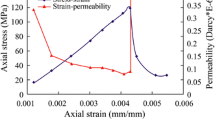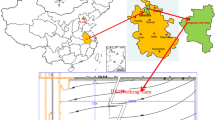Abstract
Floor water hazards pose an increasingly prominent risk in China as coal mining depths progressively increase. Two general models of complete and structural floor water inrush that consider the coupled effect of mining stress and water pressure were developed to address the problems caused by highly confined aquifers under these complex stress conditions. We developed an integrated floor water inrush model, and the floor rock mass was rezoned based on the deformation, failure characteristics, and water inrush mechanism of water-resistant floor strata under the combined action of confined water pressure and mine pressure. The formation of the coupled solid–fluid confined water uplift zone was studied from the perspective of fracture propagation. A formulation was obtained that describes the confined floor water under the coupled effects of mine pressure, water pressure, and solid–fluid interaction. An inrush risk prediction is proposed that considers the relationship between the confined water pressure and horizontal principal stress in the bottom plate’s pressure relief zone.
Resumen
Los riesgos del agua del suelo de mina son crecientes en China a medida que aumentan progresivamente las profundidades de las minas de carbón. Se desarrollaron dos modelos generales de irrupción de agua en el suelo que consideran el efecto acoplado de la tensión minera y la presión del agua para abordar los problemas causados por los acuíferos altamente confinados bajo estas complejas condiciones de tensión. Desarrollamos un modelo integrado de irrupción de agua en el suelo y el macizo rocoso del suelo se dividió en zonas basándose en la deformación, las características de fallo y el mecanismo de irrupción de agua de los estratos del suelo resistentes al agua bajo la acción combinada de la presión del agua confinada y la presión de la mina. Se estudió la formación de la zona de levantamiento de agua confinada acoplada sólido-fluido desde la perspectiva de la propagación de la fractura. Se obtuvo una formulación que describe el agua confinada del suelo bajo los efectos acoplados de la presión de la mina, la presión del agua y la interacción sólido-fluido. Se propone una predicción del riesgo de irrupción que considera la relación entre la presión del agua confinada y la tensión principal horizontal en la zona de alivio de presión de la placa de fondo.
抽象的
在中国, 随着煤炭开采深度增加, 底板水害风险日益增大。考虑采动围岩压力与底板水压耦合作用, 建立了完整底板突水和构造底板突水两种突水模型, 以解决复杂应力条件下高承压含水层底板突水问题。建立了综合底板突水模型; 基于承受水压和矿压共同作用下底板阻水岩层的变形规律、破坏特征和突水机, 进行了底板岩体重新分区。从裂缝扩展角度, 研究了固-液耦合承压上升区的形成。研究得出了描述底板承压水受矿压、水压与固-液作用耦合影响的公式, 提出了一种考虑底板卸压区承受水压与水平主应力关系的突水危险性预测方法。
Zusammenfassung
Die Gefahr von Sohlwassereinbrüchen stellt in China, mit zunehmender Teufe des Kohlebergbaus, ein immer größeres Risiko dar. Zwei allgemeine Modelle des vollständigen und strukturellen Sohlwassereinbruchs, die den gekoppelten Effekt von Überlagerungs- und Wasserdruck berücksichtigen, wurden entwickelt, um die Probleme in den Griff zu bekommen, die durch stark gespannte Grundwässer unter den komplexen Spannungsbedingungen verursacht werden. Ein integriertes Modell für den Sohlwassereinbruch wurde entwickelt, und das Liegend wurde auf der Grundlage der Verformung, der Versagensmerkmale und des Wassereinbruchmechanismus wasserbeständiger Bodenschichten unter der kombinierten Wirkung von gespanntem Wasser und Überlagerungsdruck neu klassifiziert. Die Bildung der gekoppelten Feststoff-Fluid-Auftriebszone wurde aus der Perspektive der Bruchausbreitung untersucht. Es wurde ein Ansatz gefunden, der das eingeschlossene Sohlwasser unter den gekoppelten Auswirkungen von Überlagerungsdruck, Wasserdruck und Feststoff-Fluid-Wechselwirkung beschreibt. Eine Einbruchsrisikoprognose, die die Beziehung zwischen dem Druck des gespannten Wassers und der horizontalen Hauptspannung in der Druckentlastungszone der Sohle berücksichtigt, wird vorgeschlagen.






Similar content being viewed by others
References
Bai H (2011) Study on seepage mechanics characteristics of top strata of Ordovician and its application as key water-resisting layer. Rock Mech Eng 06:1297–1297 (in Chinese)
Derakhshannia M, Dalvand S, Asakereh B, Ostad-Ali-Askari K (2020) Corrosion and deposition in Karoon River, Iran, based on hydrometric stations. Int J Hydrol Sci Technol 10(4):334–345. https://doi.org/10.1504/IJHST.2020.108264
Guo W, Zhang S, Sun W, Chen J (2018) Water inrush disaster mode and experimental application of floor in deep mining. J Coal 43(01):219–227 (in Chinese)
Hu X (2015) Study on activation and hydraulic mechanism of underlying plate. University of Mining and Technology, Xuzhou (in Chinese)
Hu W, Tian Q (2010) Types of coal mine water disasters and their prevention and control measures in China. Coal Sci Technol 38(01):92–96 (in Chinese)
Li B (1999) The theory and development and application of ‘lower three zones’ for preventing water inrush from mine floor. J Shandong Min Univ 4:11–18 (in Chinese)
Li C, Zhang Y, Zuo J, Tang S, Liu S (2019) Mechanical behavior and zoning characteristics of floor failure caused by instability disturbance of masonry beams in deep mining. J Coal 44(05):1508–1520 (in Chinese)
Liu Q (2009) Discussion on water inrush coefficient. Coal Geol Explor 37(4):34–42 (in Chinese)
Ma K, Yin L, Chen J, Chen M, Wang Z, Cui B (2018) Theoretical analysis on the failure of the key water-resisting layer of the floor in deep mining under the action of local high confined water. Geotech Mech 39(09):3213–3322 (in Chinese)
Ostad-Ali-Askari K, Ghorbanizadeh Kharazi H, Shayannejad M, Zareian MJ (2020) Effect of climate change on precipitation patterns in an arid region using GCM models: case study of Isfahan-Borkhar Plain. Nat Hazards Rev 21(2):2020. https://doi.org/10.1061/(ASCE)NH.1527-6996.0000367
Pan R, Meng X, Gao Z (2013) Lift mechanism of bottom plate guide belt under hydraulic rock. Coal Mine Safe 44(10):182–184 (in Chinese)
Song Z (1998) Practical mine pressure control. China University of Mining and Technology Press, Xuzhou (in Chinese)
Vanani HR, Shayannejad M, Tudeshki ARS, Ostad-Ali-Askari K, Eslamian S, Mohri-Esfahani E, Haeri-Hamedani M, Jabbari H (2017) Development of a new method for determination of infiltration coefficients in furrow irrigation with natural non-uniformity of slope. Sustain Water Resour Manag 3(163):169. https://doi.org/10.1007/s40899-017-0091-x
Wang Z, Liu H (1993) Mining on confined water. Coal Industry Press, Beijing (in Chinese)
Wu Q, Zhang B, Zhao W, Liu S (2013) A new practical method for evaluating water inrush from coal seam floor V : comparison of ANN type, evidence weight type and Logistic regression vulnerability index method based on GIS. J Coal 1:21–26 (in Chinese)
Xu Z (2011) Deep mining floor failure and high pressure water inrush mode, precursor and prevention. J Coal 8:1421–1422 (in Chinese)
Yin S, Hu W (2008) Study on water resistance and natural rise height. Coal Field Geol Explor 2008(01):34–36 (in Chinese)
Zhang W (2010) Study on hydraulic mechanism and risk prediction of crack base plate based on percolation-stress coupling. Shandong University of Science and Technology, Qingdao (in Chinese)
Zhang X (2020) Fracture mechanics. Tsinghua University Press, Beijing (in Chinese)
Zhang J, Liu T (1997) Research on permeability characteristics of fractured rock mass. Coal J 22(5):481–485 (in Chinese)
Zhang Y, Pang Y (2010) Hydraulic model based on stress-seepage coupling theory. J China U Min Technol 39(9):659–664 (in Chinese)
Zhang F, Meng X, Gao Z (2013) Study on the mechanism of coal plate. Safe Environ Protect Min 40(02):1–4 (in Chinese)
Zhang S, Guo W, Sun W, Li Y, Wang H (2015) Experimental study on extension activation and water inrush of concealed structures in deep mining. Geotech Mech 36(11):3111–3120 (in Chinese)
Zhang Z, Zhang Y, Zhang F (2021) Characteristics of bottom plate damage under both mining and hidden fault. Coal Mine Safe 52(01):194–199 (in Chinese)
Zhao Q, Zhao X, Wu Q, Liu C, Wang X (2015) Water inrush mechanism of break through by time and zone in deep mining floor of North China coalfield. J Coal 40(07):1601–1607 (in Chinese)
Acknowledgements
We thank Esther Posner, PhD, from Liwen Bianji, Edanz Editing China (http://www.liwenbianji.cn/ac), for editing the English text of a draft of this manuscript.
Funding
Funding was provided by China’s National Natural Science Fund (Grant no. 51874177).
Author information
Authors and Affiliations
Corresponding author
Rights and permissions
About this article
Cite this article
Zhang, Y., Li, F. Prediction of Water Inrush from Coal Seam Floors Based on the Effective Barrier Thickness. Mine Water Environ 41, 168–175 (2022). https://doi.org/10.1007/s10230-022-00846-x
Received:
Accepted:
Published:
Issue Date:
DOI: https://doi.org/10.1007/s10230-022-00846-x




